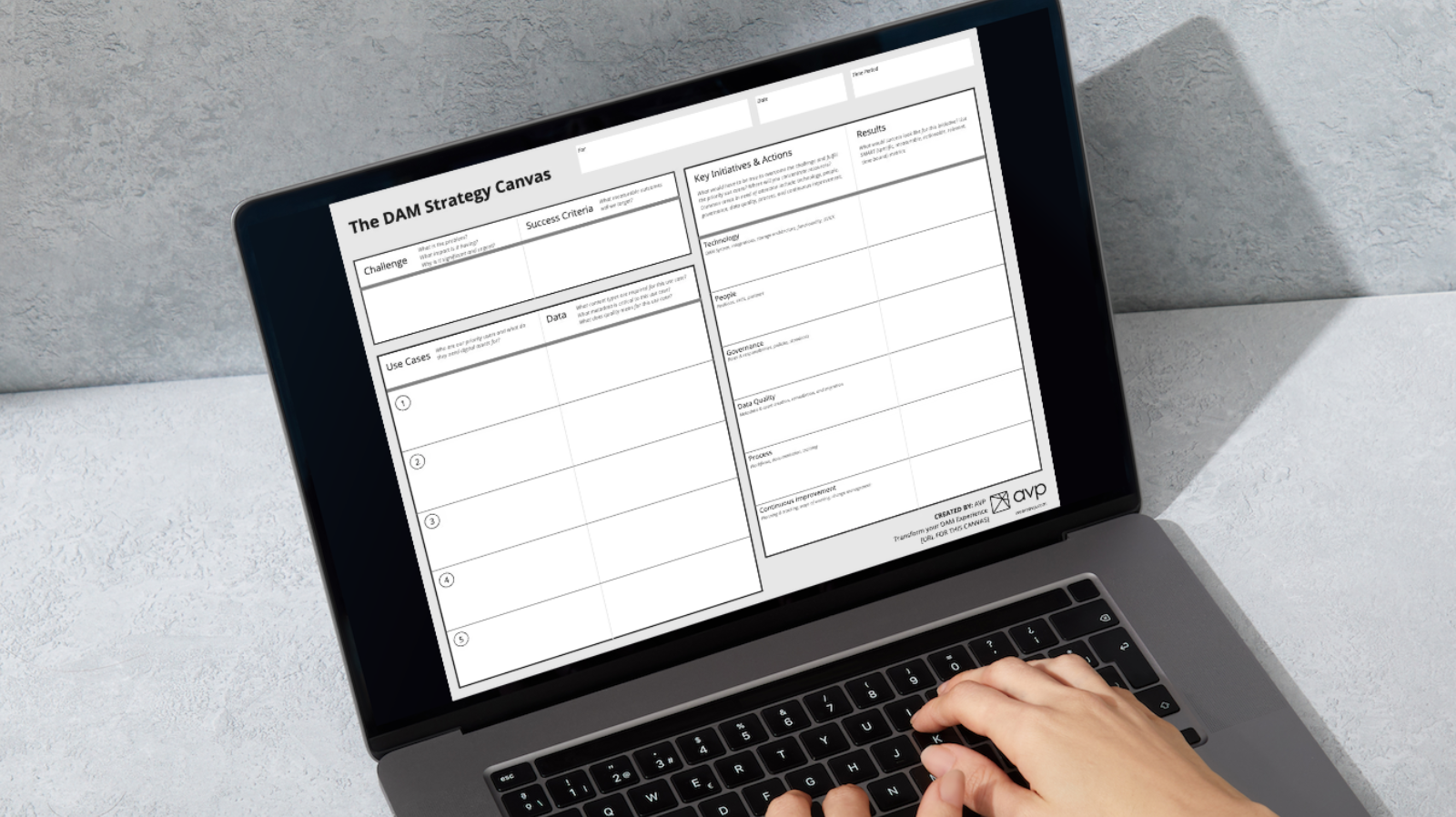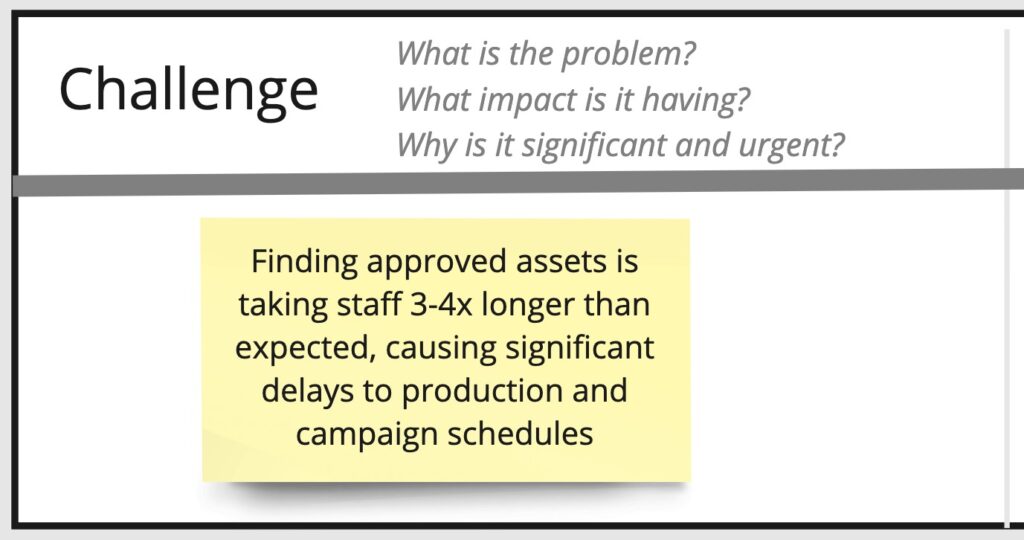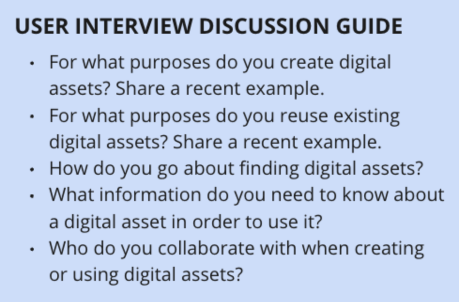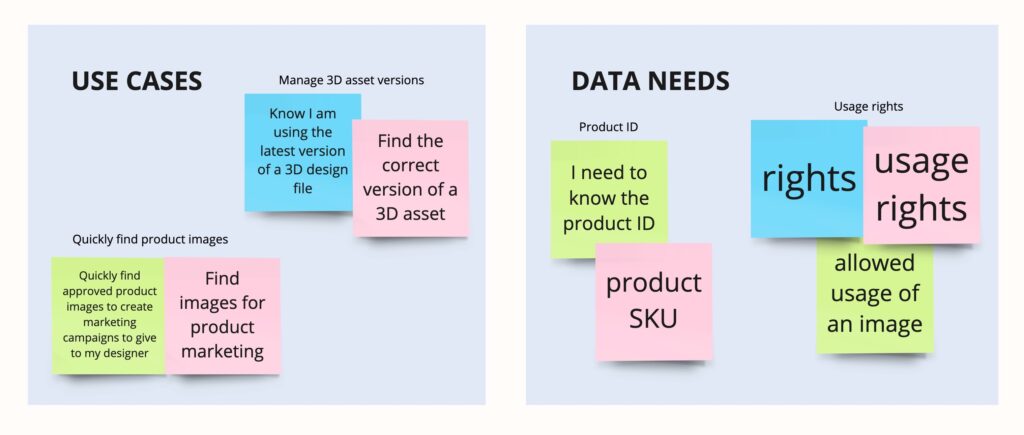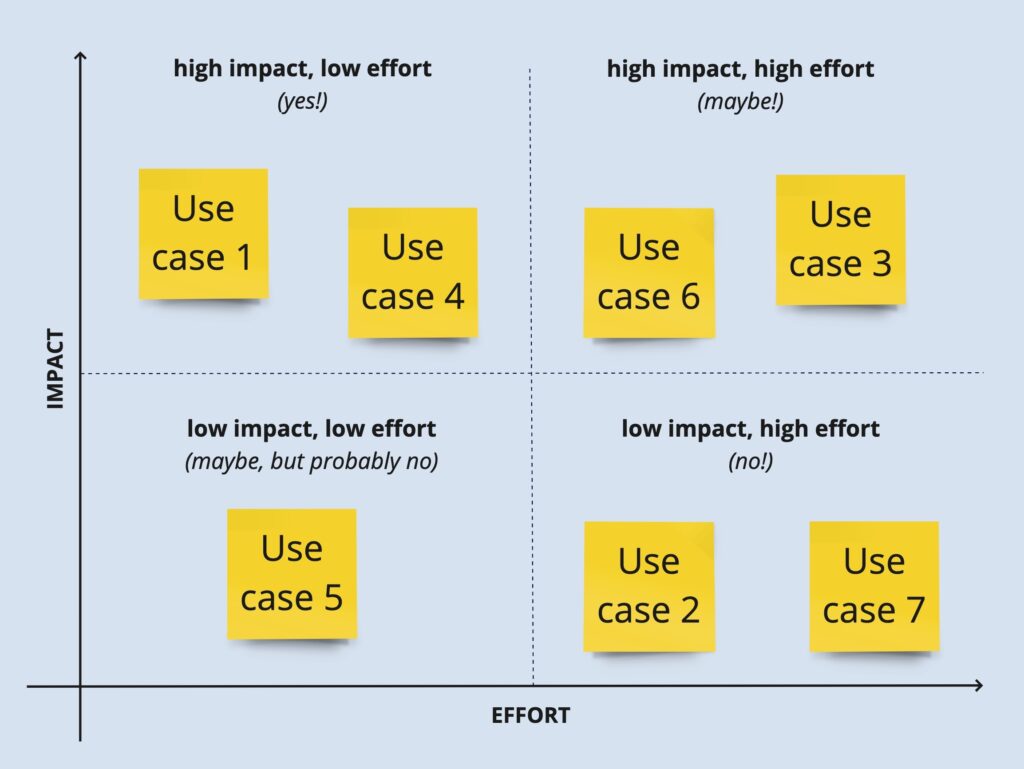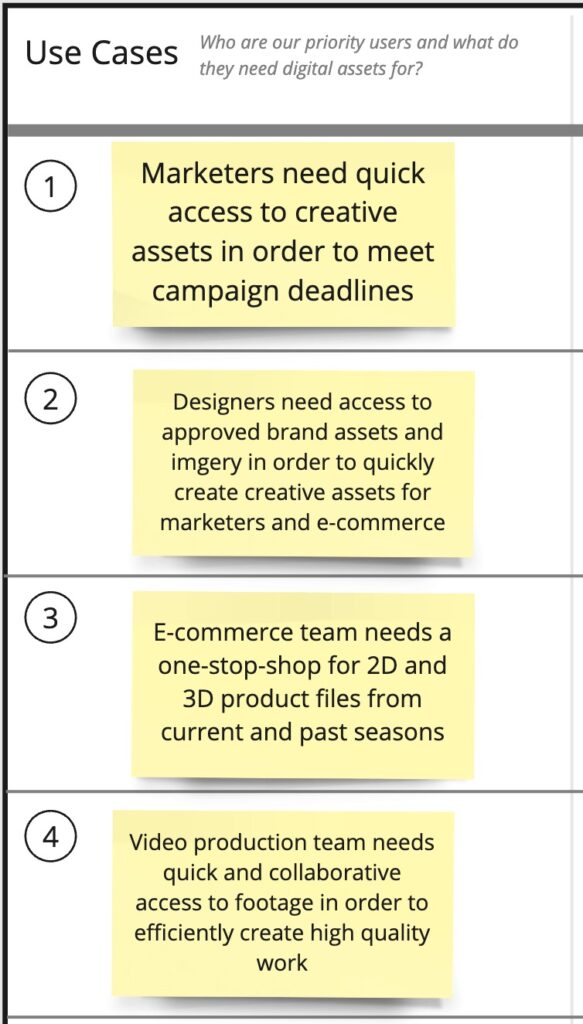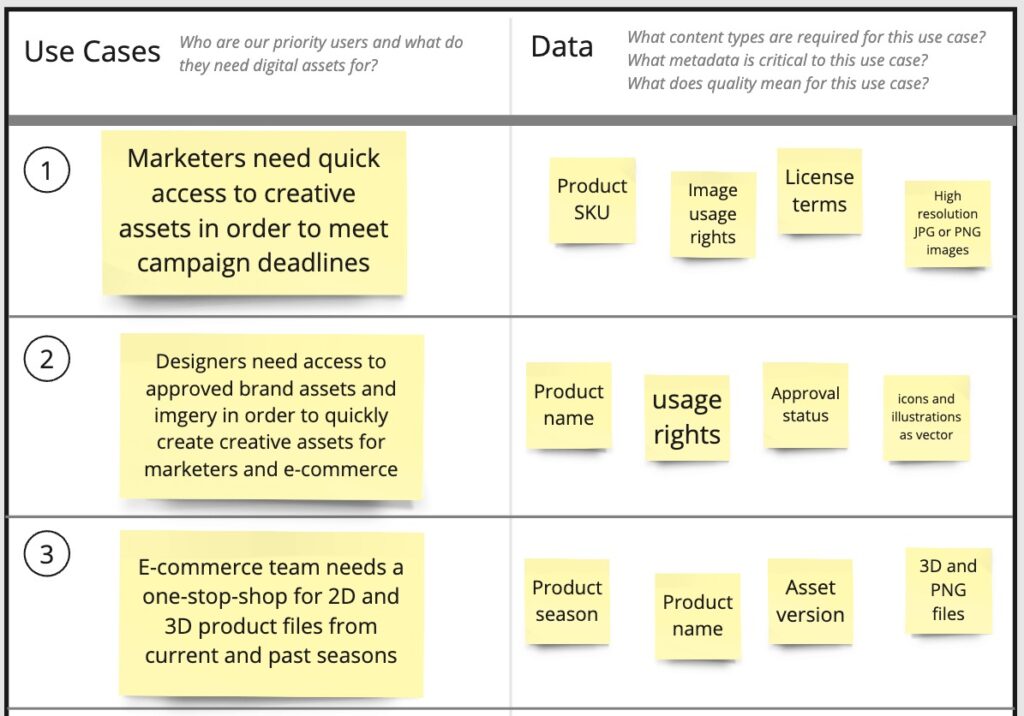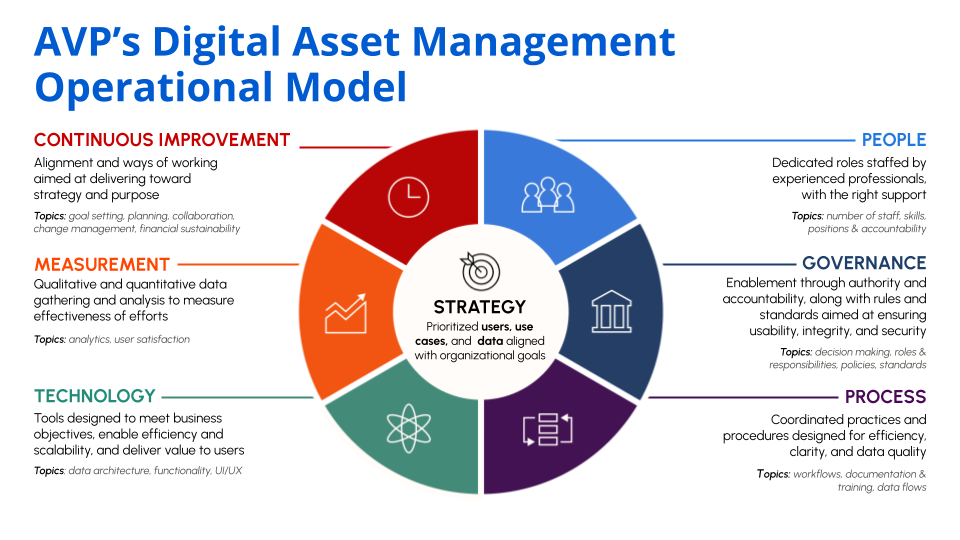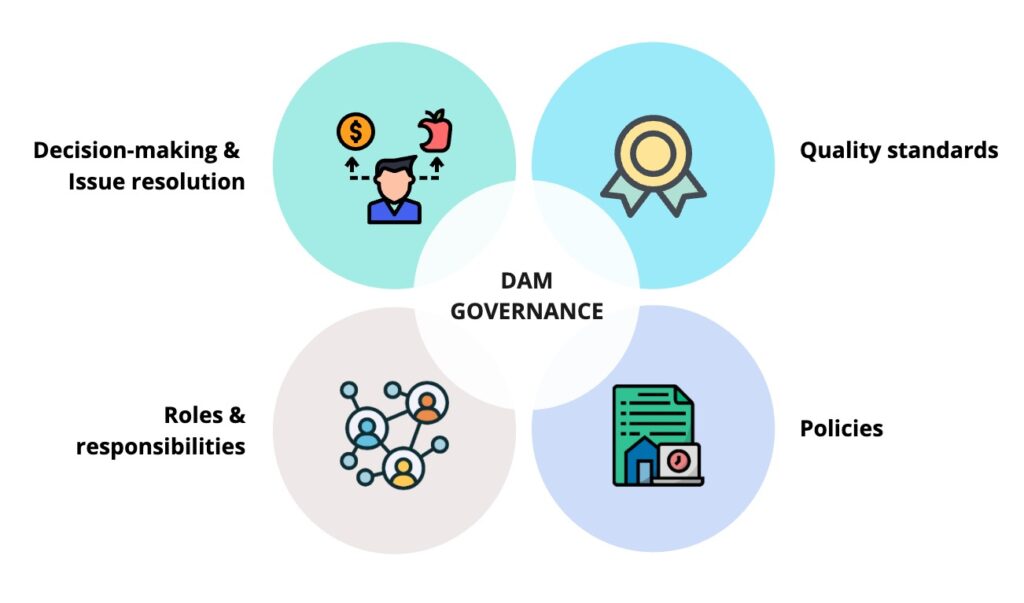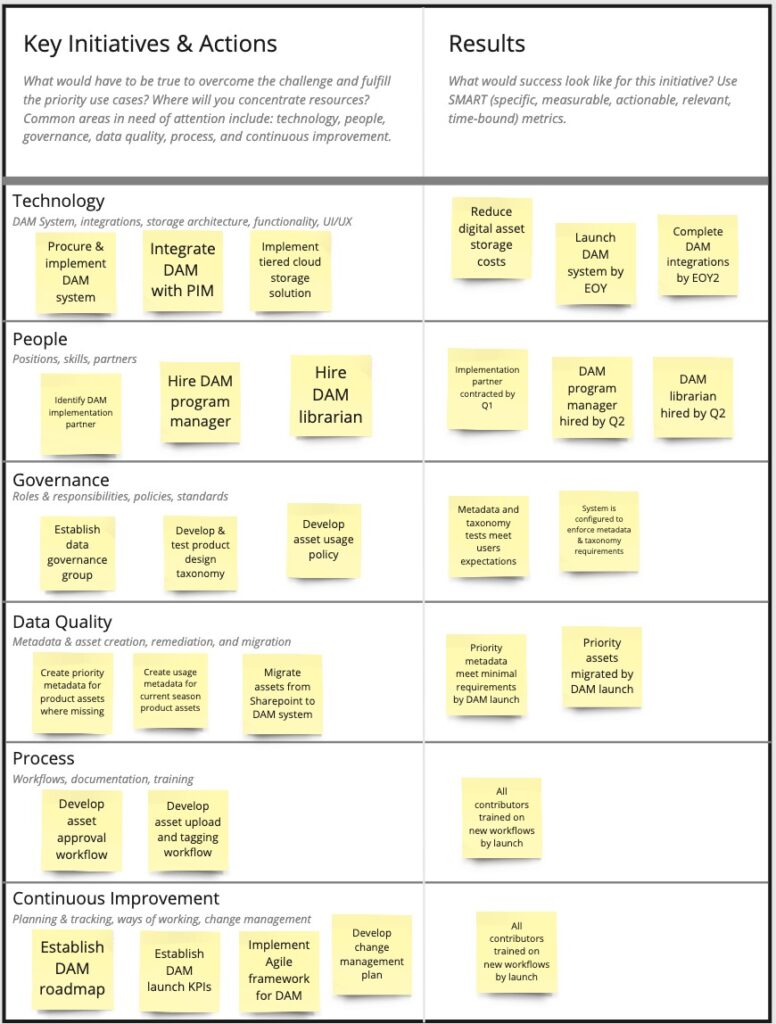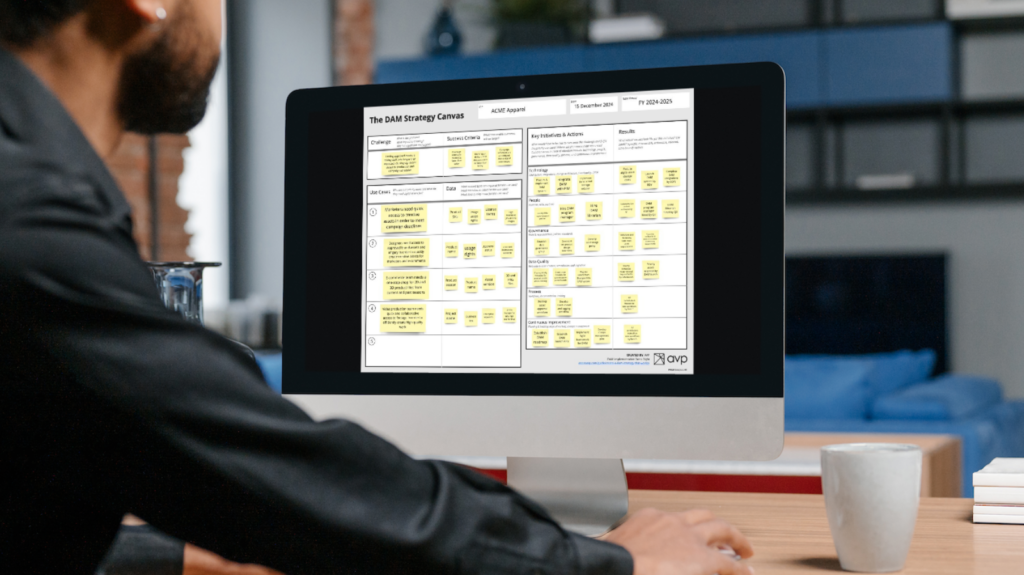How to Create a Digital Asset Management Strategy that Works
Introduction
The 2023 State of Digital Asset Management report by Brandfolder + Demand Metric found that 77% of study participants were satisfied with their digital asset management (DAM) solution when deployment was completed quickly. However, in the rush to join this satisfied majority, many companies find themselves adrift in a sea of digital chaos.
Picture a company drowning in its own digital creations. Valuable assets are being lost in a haze of disorganization, resulting in missed opportunities, misuse, and drained resources. The decision to adopt a digital asset management system ignites hope across the organization. Still, eagerness for swift deployment often clashes with reality. The pursuit of rapid implementation and excessive features can overshadow the genuine needs of users, resulting in low adoption rates and a disappointing return on investment.
Successfully navigating this scenario hinges on a focused DAM strategy. By prioritizing user needs, organizations can plot a course towards a DAM solution that not only achieves swift adoption but also ensures a clear return on investment and a scalable future. Let’s explore how to set these priorities and approach your DAM initiative with confidence.
Why is a digital asset management strategy needed?
A DAM strategy is a guiding light, providing a path to meaningful outcomes. It ensures your energy, resources, and time are focused where they truly matter, preventing wasteful detours that could jeopardize stakeholder support and trust.
Digital files—images, audio, videos, graphics, presentations, documents, and more—are like any other form of data. They can be assets, an annoyance, and or even a liability to your organization. As assets, they are resources that hold enduring value. Yet, it’s not just the files themselves, but also the accompanying metadata that gives them purpose. Think of a photo: knowing who is in it, and where and how you can use it is just as important as having the jpg. This fusion of media, metadata, and the right to reuse sets them apart as assets, not just files.
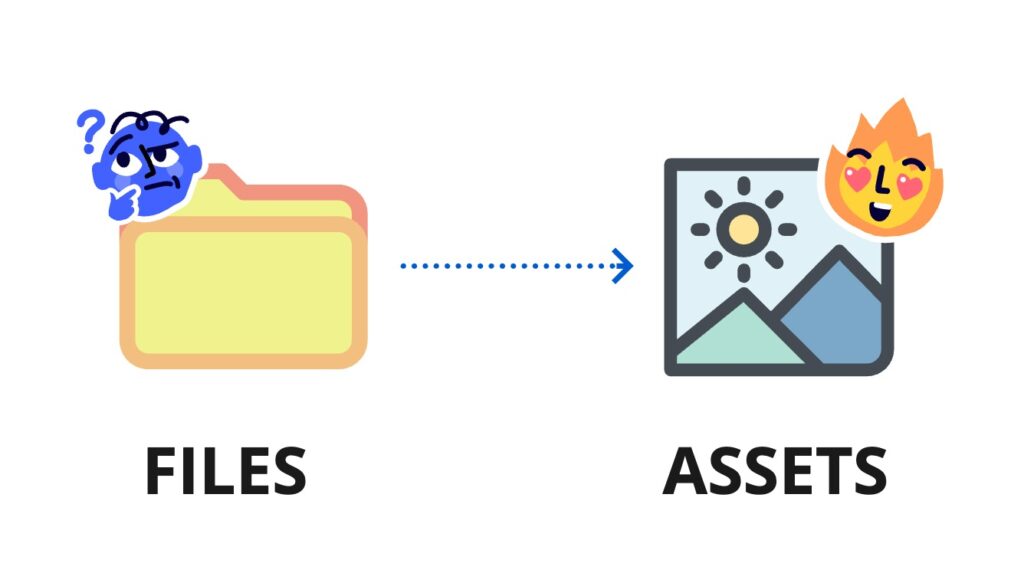
But turning digital files into digital assets requires investment—technology, staffing, processes, policies, governance—the works. This investment should be strategic, focused where it packs the most punch and sets the stage for scalable growth.
So, when does a DAM strategy matter? Anytime you face hurdles in finding, using, or safeguarding digital assets. Think of when:
Your asset collection makes finding files feel like searching for a needle in a haystack.
Multiple departmental DAMS beg for unity under an enterprise DAM software.
Your legacy DAM software no longer keeps up with your evolving needs.
Your current DAM setup needs expansion or optimization.
These scenarios aren’t just inconveniences. They lead to inefficiencies, frustration, misuse, and needless duplication. This is where your DAM strategy comes in. It ensures your energy and resources are channeled into solving real problems, ensuring a meaningful payoff from your investment.
What is a digital asset management strategy?
Strategy is problem-solving. It is how you overcome the obstacles that stand between where you are and what you want to achieve.
Richard Rumelt
A digital asset management strategy is an organization’s planned response to the challenge of needing to organize, secure, and deliver digital assets to the users that need them, now and in the future.
More specifically, a digital asset management strategy identifies priorities so you can put resources where they will have the most impact. To state the obvious — you can’t do everything at once. A DAM strategy will tell you where to start, where to go next, what to put on the back burner, and what success looks like. Good strategy is as much about what you won’t do as it is about what you will do.
Our approach? Put users first. A user-centered DAM strategy centers on understanding and addressing user needs, and developing a cohesive response that will effectively address those needs.
Ready to dive in? Let’s develop a strategy that responds to your organization’s unique needs and goals.
What does a digital asset management strategy consist of?
Our approach to DAM strategy is rooted in the framework developed by Richard Rumelt and described in his book, Good Strategy Bad Strategy: The Difference and Why It Matters. Rumelt emphasizes that good strategy is simple. It consists of a diagnosis of the challenge that you are responding to, a guiding policy that describes the approach you will take to responding to the challenge, and a set of coherent actions designed to carry out the guiding policy.
We can adapt this framework to data and digital asset management this way:
- The diagnosis is the identification of the problem an organization has with digital asset management, use, and delivery. Specifically, the diagnosis details what impact this issue is having on people (e.g., users waste time looking for assets, assets are misused)
- The guiding policy is that a use-case centered approach will be taken to solve these challenges.
- The coherent actions are the key areas of investment that you will make to solve the challenge and meet users’ needs.

Using this framework, a user-centered digital asset management strategy can be structured as follows:
- Challenge: A clear identification of the problem that the DAM strategy is responding to. The goal of this statement is to align stakeholders on what you are solving for, and to guide prioritization.
- Use cases & data: Prioritized and sequenced high-level digital asset use cases that identify practical applications of asset use, as well as the assets and metadata that are needed to enable those use cases.
- Initiatives & actions: A summary of key investments and actions that will enable the guiding use cases, including: data quality remediation efforts, technology initiatives, and enablers such as governance, process, people and continuous improvement.
We have developed a DAM Strategy Canvas to help you iteratively capture your ideas along the way. Throughout this guide, we will point out where and when to populate the different sections of the canvas.
Steps to developing a digital asset management strategy
We suggest building your DAM strategy in this order:
- Agree on the problem: Align stakeholders around the key challenge, and ensure alignment with the broader organizational strategy.
- Assess user needs: Learn from priority users about their specific needs and requirements.
- Develop use cases and data requirements: Document priority use cases that will drive the DAM strategy. Identify and document the associated data needs for each use case.
- Conduct a data quality, technical, and operational gap analysis: Assess the data, technology, and operational landscape and determine what investments will be needed for success.
- Prioritize key initiatives and actions: Identify and prioritize initiatives based on an understanding of data quality, dependencies, and technology and operational resource needs.
- Define success: Identify the key metrics that will indicate that you have successfully solved the problem
- Communicate, execute, and iterate: Ensure transparency, foster buy-in, support change management, and be ready to adapt.
Let’s dive into each of these steps.
1. Agree on the problem
Aligning stakeholders around the identified digital asset management challenge is a crucial first step in developing a successful DAM strategy. Gaining clarity on the problem to be solved will help focus subsequent efforts on a clear objective. Articulating the problem will also aid in presenting the business case for proposed investments. The problem should be significant enough to necessitate a strategic response.
To start, explore the need for an improved DAM solution within your organization. Engage stakeholders from different departments and levels of seniority to gather diverse perspectives and insights. These stakeholders can articulate how digital asset problems impact the business and provide insights into opportunities, resources, and constraints, especially budgetary concerns.
💡Tip!
Stakeholder Interviews 101 by the Nielsen Norman Group offer excellent tips on planning and conducting this type of interview.
By examining the issue from various perspectives, you can identify common themes and begin to coalesce around a top concern.
Be careful at this stage to focus only on the problem, not potential solutions. And don’t bake solutions into problem statements. For example: “We need DAM software” is a solution, not a problem. “It is taking people days to find the right asset, causing us delays to campaign timelines” is a problem.
As you narrow down the problem, it can be useful to articulate it using a Situation-Complication-Question framework. First, describe the situation — what is the problematic thing happening? Next, add in the complication — why is this happening, and what are the stakes? Finally, frame the challenge as a question — how might we resolve the situation given the complication?
Once key stakeholders align on the diagnosis and framing of the problem, populate the Challenge section of your DAM Strategy Canvas.
2. Assess users’ needs
The next step in building your digital asset management strategy is to identify and prioritize key digital asset use cases, and the data that are required for those uses to be successful.
Start by taking a deep dive into exploring users’ needs. First, identify and prioritize the users and stakeholders who rely on digital assets and are most affected by the problem you are working to solve. Seek to understand the situation from their point of view. Conducting user interviews allows you to empathize with users and gather insights on their challenges, while helping create further alignment and fostering buy-in.
Prepare an interview discussion guide that lists key topics you will want to learn about from your interviewees, including the use cases they need digital assets for, the types of assets they need, and the information accompanying the assets that are important.
💡Tip!
While you are talking to users, press for some hard numbers on how much time they spend searching for assets or money they are spending recreating and managing digital assets now. This qualitative information can be used to measure ROI against later and demonstrate the impact of the digital asset management solution.
Record and take notes during user interviews to help develop use cases and requirements in the next step.
3. Prioritize use cases and data requirements
Once you have completed user interviews, synthesize the results to look for recurring pain points, common requests, and top priorities. The results of this exercise will help you identify:
- The priority use cases your digital asset management program should serve
- What digital assets are most important to users
- What metadata are most important for search, browse, and use of digital assets
One way to synthesize your findings is to do an affinity mapping, or clustering, exercise. First, highlight any key findings from notes or transcripts. Next, put these highlights on sticky notes (one finding per note) then add these to a physical or virtual whiteboard. Reorganize notes into clusters around common themes, then label the cluster of sticky notes.
In the example above, each color note represents a different user. In the Use Cases box, we have one cluster about quickly finding product images for marketing campaigns, and another about 3D asset versions. The Data Needs box shows one cluster shows where multiple people have said that rights/usage information is important to them, and another where two people indicate that the product ID or SKU is important. When multiple people ask for the same thing, these are candidates for prioritization.
Be sure to include sections of your affinity map for:
- Use cases
- Data needs (including required files, formats, and metadata)
- Technology and functional needs
Use Cases
Your next goal is to identify the highest priority digital asset use cases that the strategy will focus on. Use cases should be high level, simple, and clear. They should identify who the user is, what they want to do with digital assets, and why. As a bonus, include the frequency of use.
Here is a simple example use case: “Marketers need quick access to brand assets every day in order to develop campaigns about our products.” This statement is concise, it identifies the user, it describes what they need assets for, and how frequently. Your use cases can be more detailed than this, but don’t make them overly complex.
Once you have sketched out the key use cases, sequence them according to priority. This will be the order in which you will start to build your DAM solution.
The key is to remember — and to clearly communicate to all stakeholders — that these foundational use cases are more than solutions for specific user groups. You will build capabilities for these use cases in a way that also addresses the needs of many other users, both current and future.
Prioritizing use cases requires weighing several factors around need, impact, and feasibility. An impact-effort mapping exercise can be helpful at this point. Start by creating a two by two grid where one axis is Impact and the other is Effort. Plot your use cases on the grid by considering them relative to one another.
The use cases that land in the High Impact / Low Effort quadrant are probably your first priorities, followed by High Impact / High Effort. Those that fall into the Low Impact area of the grid should not be part of your digital asset management strategy at this stage.
Once you have agreement on the top use cases and their priority order, populate the Use Cases section of your DAM Strategy Canvas.
Data Requirements
Once you have settled on the priority use cases, determine the corresponding data (asset and metadata) needs. We suggest approaching this by drafting a series of questions that users will be asking about digital assets when they try to find and use them.
For our product marketing use case above, the user may be asking:
- What images of a specific product do we have?
- In what territories can I use each product image?
- How should I credit the image?
Your goal is to ensure that your DAM solution can easily answer users’ top questions, so it’s important to clearly identify what those questions are. Talk to your users again if needed.
Once you have the questions listed, turn these into data needs. Consider the types of unique data assets needed to fulfill the priority use cases. Then, determine what metadata you will need to answer those questions.
Returning to the marketing use case, we recognize that marketers require product images (asset type), and for each image, they need to know in what territories they can use it (metadata), and how to attribute the image (metadata).
Once you have clarified the main data points and needs, populate the Data section of your DAM Strategy Canvas. We realize that this may end up being a level of detail more than you can fit on the canvas. Feel free to create a supplementary sheet to keep track of everything.
At the end of this step you should have a good sense of who needs digital assets, for what purposes, which types of assets, and what are the most important metadata. Next you will figure out how to deliver on those priorities.
4. Conduct a data, technical, and operational gap analysis
At this point you have identified what your digital asset management strategy needs to solve for – the challenge, the use cases, and the data needs. Next, determine the key initiatives and actions needed to deliver results. This will require taking a close look at the current state of your data, as well as your existing digital assets, asset technology and operations, and flagging any gaps between where you are today, and where you want to go.
💡Tip!
Learn more about AVP’s Technical And Operational Model for DAM Success to help with your assessment!
As you work through these technology and operations topics, jot down ideas of improvements you might need to make in each area to solve the key challenge. You will later go through an exercise to prioritize and turn these into key actions.
Technology
During user and stakeholder interviews, you probably heard a lot about the technological capabilities and functionality that people want. Now that you have these inputs, take time to draft a set of key requirements for digital asset management technology. Don’t get too lost in the details at this stage; concentrate on the real deal breakers. Identify what functionality is absolutely necessary for the success of this DAM strategy.
Next, take a look at your current technology ecosystem. Does it support this functionality today? If yes, then congratulations! Technology is not going to be one of your key initiatives.
If it does not, then you are likely looking at a technology investment, most likely in a digital asset management software, and possibly other technologies. Consider the entire scope of the use cases, and the technical environment to determine whether things like storage solutions, and/or integrations with downstream or upstream systems will be needed. It is easy to get into the mindset that everything is equally important when thinking about technology. Focus on the must-haves, rather than the nice-to-haves.
Governance
Governance is the combination of decision-making, issue resolution, roles, responsibilities, policies, and standards that work to ensure ongoing data quality, protect the organization, and manage risk. When evaluating this area, think about:
- Roles & responsibilities – What roles will be needed for ongoing digital asset management, including product or system management, asset and metadata creation, quality assurance, and user support? Do they exist today?
- Standards – Do guidelines exist that tell people how to create quality assets and metadata that align with priority use cases? Do taxonomies exist that structure and organize assets? Do you keep them up to date?
- Policies – What rules are in place to guide security, permissions, usage, and retention? Are they effective? Do you keep them up to date?
After assessing these elements, think about the changes you might need to make to achieve your goals.
Data quality
Now that you understand users’ expectations for digital assets, metadata and overall quality, what needs to happen to bring existing digital assets in line with those expectations? Are the priority asset types readily available to the priority users? Are you consistently capturing and applying key metadata? Do you have a taxonomy that structures assets so that they are easy to search for, find, and interpret?
If during user interviews you heard that people are struggling to find, understand, and use digital assets, the answer to these questions is probably – NO. At this point your main goal is to identify where the main issues and needs are for those priority use cases. Consider data or asset creation (where they don’t exist), remediation (where cleanup is needed), and/or migration (when consolidation is needed).
Process
This area includes digital asset management workflows, business processes, documentation, and training, all oriented around fulfilling the priority use cases and ensuring ongoing data quality. When exploring the the current state and needs around process, consider:
- What digital asset workflows exist today? How well are they followed?
- How are new staff trained in digital asset creation and usage?
- What documentation exists for people to refer to when they have a question? How easy is it to access? Does everyone know where to find it?
- How do users submit questions, report bugs, and get troubleshooting help?
Note anything that feels missing or insufficient here.
People
Digital assets don’t make, organize, describe, and quality assure themselves (AI can increasingly help with some of these tasks, but humans will still need to be in the loop 😉). What skills, areas of expertise, and positions are needed to fulfill the roles and responsibilities outlined in your governance review? Think about the DAM-specific staffing (DAM managers, taxonomists, etc) as well as partners in your technology organization.
Consider your short-term and long-term needs. Do you need additional expertise and capacity to implement your DAM strategy? Are those people available internally, or will external resources be needed? This may be another area of potential investment to flag.
Continuous Improvement
Continuous improvement covers a range of topics including: goal setting and roadmapping, measurement and tracking, collaboration and ways of working, and change management. To evaluate this area, ask:
- Do we have a mechanism for creating goals and milestones for the DAM program?
- Does our team have a way of working (e.g., Agile) that will help us reach our goals while remaining flexible?
- Do we consistently track progress and measure success toward our goals?
- How do we approach change management, especially considering that we are embarking on a major change initiative?
5. Prioritize Key Initiatives and Actions
The gap analysis will reveal numerous strengths and shortcomings. At this stage, another prioritization effort will need to take place to answer the question: of all of the shortcomings we have identified, which can we solve that will create value and deliver impact for the priority use cases?
Remember, the goal is to use the resources you have on the highest priority items first.
Impact/effort exercises also work well here to help scope, shape, and sequence work, which make it easier to plan and execute when the time comes to implement.
As a prioritization check, it can be helpful to map the use cases to the initiatives. Does the proposed initiative address the highest priority use cases? Does it address multiple use cases? Be cautious of proposing actions that won’t directly impact the use cases and the primary objective that the DAM strategy is addressing.
Once you have identified priority actions that consider all the key areas explored during the gap analysis exercise, write these as objectives accompanied by measurable success metrics. For example, if you noted that your organization is lacking a digital asset management system that is capable of fulfilling priority use cases, an objective could be: “Procure, implement, and launch a new DAM system,” with the result being: “DAM system is launched to beta testers by Q3 2024.” If a large data remediation effort is needed, the objective could specify the metadata attributes that need improvement, with a result that reads something like: “Implement a new metadata standard, achieving 98% compliance within six months.”
Finally, document the Key Actions and Results on your DAM Strategy Canvas.
6. Define success
If you have followed along this far, your DAM strategy canvas is nearly complete, with the exception of one section: Success Criteria!
Reflect on what success really looks like. If you were to take all of the outlined steps and invest in all of the initiatives, how would you know if you have gotten it right? What would success look like if you solved the problem?
Jot down and refine your ideas until it feels like you have right metrics. These indicators of success will become the KPIs for your overall DAM strategy.
Complete the Success Criteria section of your DAM Strategy Canvas, then review the entire thing to make sure everything you’ve included is going to help you reach those success metrics.

7. Communicate, execute, and iterate
If you have made it to this point, congratulations — you have a digital asset management strategy! If you have done this correctly, you should have diagnosed the challenge, identified a set of guiding use cases, identified the assets and metadata that are important to those use cases, and proposed a series of initiatives and actions that will allow you to stay focused on reaching the success criteria. You can now create a roadmap to sequence actions and put this strategy to work!
This DAM strategy will help you avoid making ill-fated attempts to solve for everyone and everything all at once. We have seen this approach fail countless times, resulting in half-baked solutions that leave users frustrated, losing their trust along the way.
A better way is to take an iterative approach, creating value, and continuously and iteratively building out capabilities to do more. Do a few things really well, then scale.
This is where communication and execution of your strategy becomes critical. Sharing how you developed the strategy, how you established priorities, and how you will iteratively build and execute to develop capabilities and solve for priority use cases will help you avoid the dreaded trap of pressure to do more from stakeholders. Avoiding scope creep as much as possible is critical to a successful DAM strategy.
Nevertheless, remain flexible. Over time, as organizational strategies and priorities change, you can revisit and re-prioritize the use cases and data needs in response. Your DAM Strategy will become a living document, continually being tweaked and refined as you solve for the issues that were frustrating your organization when you started.
Along the way, continue the process of engaging stakeholders for input and feedback, communicating the strategy and its evolution. Maintain transparency and clarity, and demonstrate your successes as you go.
Transform your DAM experience
Development of a digital asset management strategy may be done quickly — in an intensive workshop held over the course of a few hours. Or, it may be built incrementally over a few weeks or months.
In either case, it can be helpful to have an expert guide support the process.
At AVP, we specialize in helping organizations develop and implement DAM strategies that deliver impact. Our goal is to ensure that you end up with a plan that keeps you on track to reach your vision, that provides direction for the use of limited resources, and that ensures your users will be delighted.
We offer a few ways to jumpstart your digital asset management strategy:
- Schedule a 1 hour consulting call where we will talk through your DAM strategy planning, or review the work you have done so far
- Let us facilitate a strategy workshop for your team, and coach you through the process of creating your DAM strategy
- Engage with us in a full service DAM strategy consultation. We will facilitate stakeholder meetings, interview users, suggest key initiatives, document your complete DAM strategy, create your roadmap, develop communication plans, and present to stakeholders.
